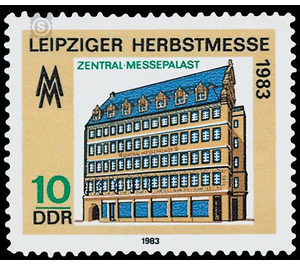Commemorative stamp series - Germany / German Democratic Republic 1983 - 10 Pfennig
Theme: Calender
| Country | Germany / German Democratic Republic |
| Issue Date | 1983 |
| Face Value | 10.00 |
| Color | multi-colored |
| Perforation | K 14 |
| Printing Type | Rotogravure 2 |
| Stamp Type | Postage stamp |
| Item Type | Stamp |
| Chronological Issue Number | 2564 |
| Chronological Chapter | GER-DDR |
| SID | 311252 |
| In 18 Wishlists | |
Leipziger Herbstmesse 1983 At the Leipzig Autumn Fair 1983, the Ministry of Posts and Telecommunications of the German Democratic Republic publishes two multicolored special postage stamps. Special cancellation from 30th August to 29th October 1983 10 Pfennig value: Zentral-Messepalast The Zentral-Messepalast, with its own distinctive face, is located at the intersection of two streets, possibly over a thousand years old. If you come from the Grimmaische Straße into the city center, you will see this beautiful, stately-seeming functional building, which, like all trade fair houses in Leipzig, is at the disposal of international trade, at a crossroads to the Neumarkt from afar. This monumental building made of shell limestone was opened on the occasion of the Spring Fair in 1914. The builder and architect of this house, Emil Franz Hänsel, rented the exhibition space available to him as a private entrepreneur. Since customers were easy to advertise in a richly decorated and prestigious building, the Central Exhibition Palace was given a sophisticated design. This is documented by the gable with pretended, four-storey oriel and a lion on the ridge, and the sculptures located at the level of the first floor, created by the sculptor Bruno Wollstätter. In 1926, Hänsel acquired the "Monopol" exhibition center, which adjoined directly to the Central Exhibition Palace, and connected the two buildings in a successful architectural design. Thus, the Central Exhibition Palace had a rentable area of about 6,000 square meters. During the Second World War, the building was completely destroyed by bombing raids. but immediately after the end of the war reconstruction began, so that the opening of the first Leipzig Peace Fair on May 8, 1946, the first exhibition rooms were provisionally available. It did not remain with this provisional arrangement - already at the spring fair 1947 all five exhibition days were usable again. The newly built with much effort and high cost building is today again one of the most beautiful exhibition halls in Leipzig. On around 4,500 square meters, exhibitors from such traditional industries as polygraphic products and paper goods are represented here twice a year with their exhibits.


